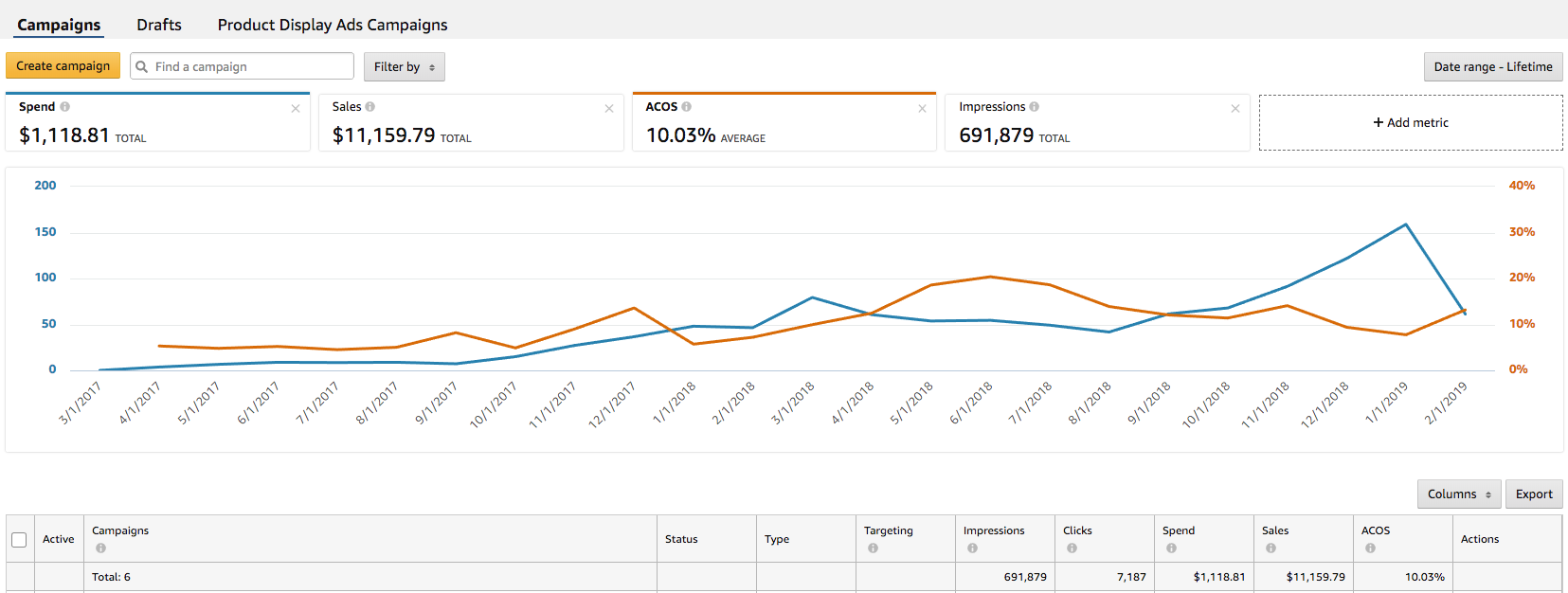
Today’s guest post is by Dave Chesson (@DaveChesson) of Kindlepreneur.
Amazon is always looking for better ways to crank out a higher profit margin. While some of their updates have been much to the chagrin of authors, recent changes to their book advertising system should help authors make better decisions about their ads and target their markets more precisely.
But it’s not all good. I’m leery of some aspects I think might be problematic.
Note: If you’re less familiar with Amazon ads or aren’t sure how to create them, then check out my complete, free video course on Amazon book advertising.
Amazon advertising: What has changed?
A couple of months ago, Amazon changed the name of their advertising platform from Amazon Marketing Services (AMS) to Amazon Ads, which is why you might still see people, myself included, call it AMS.
On January 7, 2019, Amazon made some significant changes to the AMS features. Although there are slight variations throughout the entire system, most of the major changes can be grouped into three categories:
- New Advertising Modes
- Improved Dashboard
- Better Advertising Targeting
1. New Amazon advertising modes
The first change we’ll explore is how Amazon has altered their advertising modes. Previously, authors had a choice of two methods to advertise their book:
- Sponsored Product Ads
- Product Display Ads

View of Kindle lock screen
However, Amazon has removed Product Display Ads and instead created Lock Screen Ads. Simply put, this allows you to display your ad on the screen of a Kindle when it is locked as well as on the home page of a Kindle device.
It works a little differently depending on whether the user has a Kindle Fire or not, but the basic principle is the same: when someone opens their Kindle, they will see your ad either on the lock screen or the home page—and hopefully click it.
While some authors believe this is helping their sales, I personally am not a fan of these ads. I believe a lot of Kindle users accidentally click on the ads on their lock screen or home screen. I know I’ve personally done this a couple of times.
The other issue I have is that I generally don’t shop for my next book using my Kindle. When I’m using the device, I’m reading a book I already have invested in. Therefore, I’m a bit wary about this option, and so far my own testing shows high clicks and low sales as compared to other modes.
2. Improved Amazon advertising dashboard
If you’re a book marketing nerd like me, this is a change you can truly get excited about!
For years I’ve been frustrated by Amazon’s dashboard—features common in any other sector of the advertising industry were not offered. To see if your ads had new impressions, or changes, you’d need to export Excel files each day and compare. Having to do this was wholly ridiculous, especially for a company as large as Amazon. Thankfully, Amazon has made some meaningful changes to their dashboard that have improved the user experience.

Here’s what’s new.
- Export. If you’ve used Amazon ads in the past, you’ll know how tedious it was to have to export your data, run it through a spreadsheet, and manipulate it outside of the Amazon environment. I have a background in engineering, so I’m kind of a technical guy, but even I found this to be frustrating. Thankfully, you can now do meaningful data manipulation within the Amazon advertising environment itself. This is a lot more efficient and saves the frustration of having to export the data.
- Filters. You can now filter the data. This is particularly useful if you are running different campaigns, or different versions of the same campaign, as you can quickly and easily compare performance.
- Timescale. Now Amazon allows you to quickly change the timescale for the data shown. You can easily see data from a particular time period. This is great to analyze trends. What direction are your ads trending in? Better or worse over time? You can use this data to make improvements to your campaign, and also to draw cause-and-effect relationships between your marketing decisions and the performance of your campaigns.
- Columns. Amazon advertising data can be a little overwhelming sometimes, particularly if you’re not used to working with quantitative information. Thankfully, Amazon has made it a lot simpler. You can now easily select which columns are displayed, allowing you to see only the data you want.
- Lifetime data. This is a great improvement. You can now easily and quickly export the lifetime data from your campaigns. This is a fantastic option to get a big picture overview.
3. Better Amazon advertising targeting
If you’re familiar with online advertising in general, you’ll know how important targeting is. After all, the ability to pinpoint your ad audience is one of the major advantages of online marketing.
As part of their upgrades, Amazon has improved the way you can target your ads and make sure you get your book in front of the market you want. Here’s some of the new targeting—plus one that isn’t as commonly known.
- Product targeting. This is good if there is a specific book you really want to get your ad next to. To target a product, you use the ASIN. This stands for “Amazon Standard Identification Number.” It’s a ten-digit code that’s unique to each Amazon product. If you want to target a particular book, the ASIN is how it’s done.
- Category targeting. Picking the right categories for your book is a key part of becoming a bestseller, and ensures the right people are exposed to your work.
- Negative targeting. This change was made last year. With negative targeting, you can now suppress your ad from display when people type in certain words or phrases. Say, for example, you have written a book about the optics of twilight—how the light looks at dusk. Using negative targeting, you could ensure your book does not show up anywhere near Twilight (vampire romance) or people looking for a book in that genre or category. This ensures your ads reach the right people, saving you money and frustration.
See the changes in action
Final thoughts about the changes
After about a month of working with the new system, I’ll give them a B+. I like the new targeting with the ASIN numbers and the categories. This new emphasis on categories gives authors the chance to expand their reach by targeting relevant categories they had to sacrifice when publishing their book (authors are only allowed to pick three categories for their metadata). So, rather than sweating your selections, you can simply add even more categories when advertising. Also, the new dashboard is light years better than the original version, but some aspects could give more insight into what’s really going on.
However, when it comes to the Lock Screen Ads, I’m not a fan. In truth, I wasn’t much of a fan of the Product Display Ads either, so swapping one for the other doesn’t change much. This one will bring Amazon more money due to more clicks, but I doubt it will have the positive ROI that authors see elsewhere. However, that isn’t to say that Lock Screen Ads won’t work for anyone.
If you’re interested in learning more or starting your ads, be sure to check out my full free course about Amazon ads. I will be updating it soon to reflect the above changes once I gain more experience with each aspect.
If you’ve been experimenting with the new changes, let other readers know your thoughts and observations in the comments below. Let’s share our knowledge, experience, and insights.

Hi, I’m Dave Chesson, and when I’m not chasing little Jedi around the house, I run Kindlepreneur.com, a website devoted to the technical side of book marketing. I love digging deep and analyzing the latest book writing tools and tactics of the trade. I’m also the creator of KDP Rocket, a software that helps to peel back the curtain on Amazon and see the wizard (or book data) behind it.

The biggest problem with the new dashboard is that it does not remember your customized column settings. So each time I load the dashboard, I need to reconfigure the columns.
I was really hoping that would be a simple fix for them and they’d figure it out – apparently their own developers don’t do AMS ads….haha.
I’ve been onto the Amazon.com site and can’t see any sign of ads any more. Does anyone know the reason?
I heard someone else say that a couple of days ago. One thing I have noticed is that Amazon is doing a LOT of testing. So, not all people in a specific location will see the same thing.
If you are using Firefox or another browser that has ad blocking the Amazon ads won’t show. Recent updates have made the ad blockers smarter about what is an ad. This seems to me to suggest that the ads are only going to reach a less tech-aware audience.
Try a different browser. That seems to be an issue on a lot of problems. Google has limits. I can’t see my keywords in Targeting unless I clear all my browsing history every time.
Also, if you have an ad blocker, that can also stop them from showing up.
[…] For those selling on Amazon, Melissa Bowersock delves into tracking Kindle sales with the Book Report app, and Dave Chesson takes a look at changes to Amazon advertising. […]
My dashboard has been acting really weird, I made a 2 min video of it is there a way I can share it here? I also sent the video to KDP but they still haven’t fixed it
I can vouch for you James 🙂 But I don’t manage this website. Try and post.
Thanks for this. I decided to move everything over to their new system this afternoon, and your information will help.
I set up a Sponsored Product Ad, but couldn’t find an option for product targeting.
I’m actually going to be updating my free course to show how to do those and also category specific ads as well.
I am so thankful Amazon FINALLY changed the dashboard! It was a mess that provided no helpful insight. I love it so far. Being able to figure out what my campaigns are doing currently (as opposed to just lifetime) is a huge help.
I wasn’t a fan of Product Display ads either. I don’t think I got even one sale off of them. I’m testing the Lock Screen ads and not impressed yet. I still do the best with my manually targeted Sponsored Product ads.
Absolutely and me too. I’m also with you on the PDA as well, but so far, I’m still not a fan of LSA.
I’m actually having trouble with the dashboard on their new format and the product targeting. When I’m on Google browser, “no data available” comes up when I want to see all my keywords and their stats. Amazon told me I have to use Safari or keep clearing my Google browser history.
Or if you have an ad blocker, that will definitely affect it.
Thanks for the updates! What is a good Ads CTR to aim for?
Honestly, that can depend on your niche/topic and its level of interest and how much you want to push to scale.
In the recently rolled out Amazon Advt facility – to target Advt based on ‘Product Category’ – like ‘Management books’, or ‘Self Help’ books, I think Amazon charges on Impressions, and not on clicks. I have been charged like this. This is unlike Amazon where for all other option – targetting specific book (ASIN), or Keywords , Amazon charges on clicks. Has anyone observed this – for me this was new.
I might be wrong in above. Possibly the ‘click’ information is yet to be uploaded by Amazon in the dashboard, though the Amazon charges and impression are visible. (This gave rise to my above comment that Amazon is charging on Impressions.) Will wait and see.
That would be my guess. Timeliness of reporting is NOT one of Amazon’s fortes.
Thank you. Just Thank you and I am checking out your Amazon Ads Course too.
Awesome and glad to have helped!